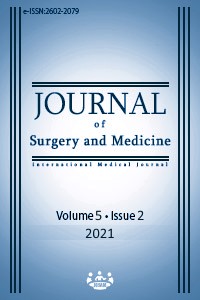Comparison of end-effector and exoskeleton devices with robot-assisted gait training in patients with stroke
Keywords:
robot-assisted gait training, stroke, end-effector robot, exoskeleton robotAbstract
Background/Aim: Loss of gait is the key problem after stroke. Robotic rehabilitation devices, which constitute the new treatment alternatives for stroke, can be divided into two groups on the basis of their design, the exoskeletons and end-effectors. This study aims to investigate the effects of gait training with two different types of robot on rehabilitation outcomes in patients with stroke. Methods: Twenty-four patients treated for stroke between December 2015 and December 2018 were included in the study. They were randomly divided into two groups for rehabilitation with either the exoskeleton or the end-effector. They attended the robotic rehabilitation programme for five days a week for six weeks, with each session lasting for 40 minutes. They were evaluated in terms of motor stage, ambulation, walking speed and walking capacity at the start and end of the programme. Results: According to baseline evaluations, there were higher scores in the endpoint evaluations for motor stage, ambulation, 6-minute walking test and lower scores in the endpoint evaluations for 10-meter walking test (P<0.001 for all). There was no difference between the two groups in terms of motor phase, ambulation, 6-minute walking or 10-meter walking scores (P>0.05 for all). Conclusion: In patients with stroke, improvements were observed following robot-assisted gait training. No superiority was observed between the end-effector device with the exoskeleton device.
Downloads
References
Adamson J, Beswıck A, Ebrahım S. Is Stroke The Most Common Cause Of Disability? J Stroke Cerebrovasc Dis. 2004;13(4):171-7.
Veerbeek JM, van Wegen E, van Peppen R, van der Wees PJ, Hendriks E, Rietberg M, et al. What is the evidence for physical therapy poststroke? A systematic review and meta-analysis. PLoS One. 2014 Feb 4;9(2):e87987.
Mehrholz J, Thomas S, Werner C, Kugler J, Pohl M, Elsner B. Electromechanical-assisted training for walking after stroke. Cochrane Database Syst Rev. 2017;May 10:5(5):CD006185.
Johnson MJ, Feng X, Johnson LM, Winters JM. Potential of a suite of robot/computer-assisted motivating systems for personalized, home-based, stroke rehabilitation. J Neuroeng Rehabil. 2007;4(1):6.
Dzahir MAM, Yamamoto S. Recent trends in lower-limb robotic rehabilitation orthosis: Control scheme and strategy for pneumatic muscle actuated gait trainers. Robotics.2014;3.2:120-48.
Veerbeek JM, van Wegen E, van Peppen, Hendriks E, Rietberg M, Kwakkel G. What is the evidence for physical therapy poststroke? A systematic review and meta-analysis. PloS One. 2014 Feb 4;9(2):e87987. doi: 10.1371/journal.pone.0087987.
Molteni F, Gasperini G, Cannaviello G, Guanziroli E. Exoskeleton and end-effector robots for upper and lower limbs rehabilitation: Narrative review. PM&R,2018;10(9):174-88.
Mehrholz J, Pohl M. Electromechanical-assisted gait training after stroke: a systematic review comparing end-effector and exoskeleton devices. J Rehabil Med. 2012;44(3):193-9.
Bruni MF, Melegari C, De Cola MC, Bramanti A, Bramanti P, Calabrò RS. What does best evidence tell us about robotic gait rehabilitation in stroke patients: a systematic review and meta-analysis. J Clin Neurosci. 2018; 48: 11-17.
Goffredo M, Lacovelli C, Russo E, Pournajaf S, Di Blasi C, Galafate, D, et al. Stroke Gait Rehabilitation: A Comparison of End-Effector, Overground Exoskeleton, and Conventional Gait Training. Applied Sciences. 2019;9(13):2627.
Hidler J, Nichols D, Pelliccio M, Brady K, Campbell DD, Kahn J H, et al. Multicenter randomized clinical trial evaluating the effectiveness of the Lokomat in subacute stroke. Neurorehabil Neural Repair. 2009;23.1:5-13.
Winstein CJ, Stein J, Arena R, Bates B, Cherney LR, Cramer SC, et al. Guidelines for adult stroke rehabilitation and recovery: a guideline for healthcare professionals from the American Heart Association/American Stroke Association. Stroke. 2016;47(6):e98-169.
Downloads
- 1274 1375
Published
Issue
Section
How to Cite
License
Copyright (c) 2021 Aylin Sarı
This work is licensed under a Creative Commons Attribution-NonCommercial-NoDerivatives 4.0 International License.
















